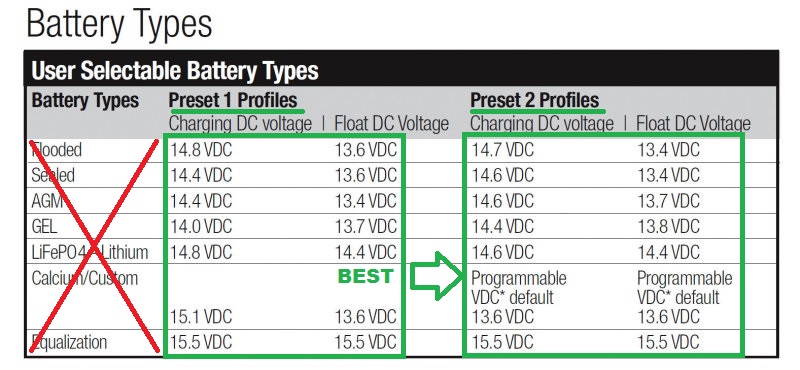I have wooden launch 11 metres (36ft), powered by a Perkins 215 horse diesel. Charging is by 140 amp alternator controlled by an Ample Power V3. I am about to replace my lead acid house batteries with AGM and am concerned that my start battery will not be fully charged unless I modify my charging arrangements. The start battery is charged from the house battery via a VSR. The Ample Power has provision to work with an AGM battery but operates at a lower voltage that with flooded call batteries. The system has served me well but it is time to replace my house batteries. What changes should I make to my charging system to accomodate the two types of battery?
Cheers
Bill
Ignore the
words/Acronyms and focus on the
voltages
Just take a big red marker and cross out the
Battery Types on your Ample regualtor. Now that you’ve done that, find the voltage settings that match
your batteries.
Let's choose a profile for a Rolls AGM battery (14.7V and 13.7V).. Do we simply select the acronym
AGM from column 1 or column 2, or should we focus on the actual voltages the battery maker wants to see?
Here's an example:
Even with 11 presets to choose from, on this charge source, how well did we do..? Now imagine you only had two or three settings?
Manufacturer suggested charging voltages:
AGM Batteries – Which “AGM” Preset works?
Lifeline AGM’s = 14.4V & 13.4V = AGM Preset #1
Odyssey TPPL AGM’s = 14.7V & 13.6V = Neither AGM Preset
Firefly AGM =14.4V & 13.2V = Neither AGM Preset
Mastervolt AGM = 14.4V & 13.2V = Neither AGM Preset
Full River AGM = 14.7V & 13.7V = Neither AGM Preset
Rolls AGM = 14.7V & 13.7V = Neither AGM Preset
East Penn/Deka = 14.6V & 13.6V = Neither AGM Preset
US Battery AGM = 14.4V & 13.4V = AGM Preset #1
Trojan AGM = 14.4V & 13.5V = Neither AGM Preset
This is why we should always buy chargers, regulators and charge controllers that have a
custom setting. Sure AGM preset #2 is pretty close but why aim for close enough. If it is all you had, that would be the best option.
Even with 11 presets only 2 out of 9 “AGM Pre-Sets” actually line up with an AGM brand. Again please don't focus not on the
words/acronyms, but rather on the
voltages they represent.
Which flooded preset works for Trojan or Deka flooded batteries?
Trojan Flooded = 14.8V & 13.5V = Neither Flooded Preset is Idea
Deka Flooded = 14.7V & 13.8V = Neither Flooded Preset is Ideal
What do all these batteries have in common? They all ideally need a user customizable voltage profile. If one of the Ample presets works for both batteries, that's great, if not choose as
close as you can for the bigger, newer and more expensive bank. A flooded start battery is inexpensive and disposable, comparatively speaking, so if you must go over or under voltage on one bank, let it be the flooded start battery not the expensive AGM bank.
Over the years I have seen too many batteries destroyed by folks following words or acronyms instead of paying attention to the actual voltages the battery manufacturer recommends. Today many quality battery chargers, controllers and voltage regulators do allow full custom programming.
Start with your brand of battery then get the recommended absorption & float charging voltages from them. For PSOC type use (partial state of charge/cruising) the
highest allowable absorption voltage will work best at fighting sulfation.
If both batteries are in the same or very similar voltage range +/- 0.1V - 0.2V for absorption (preferably within 0.1V) there won't be an issue.


